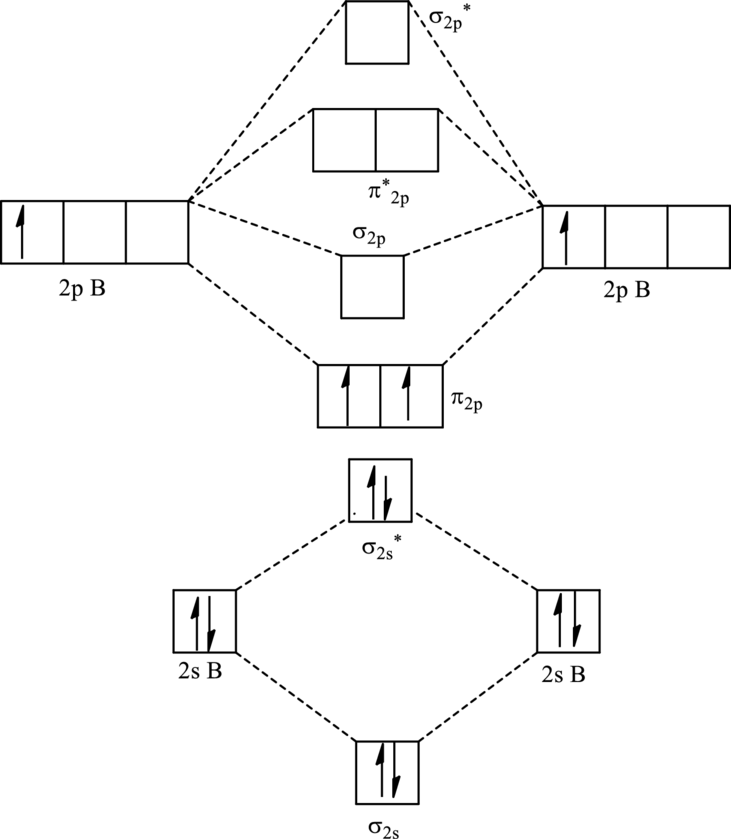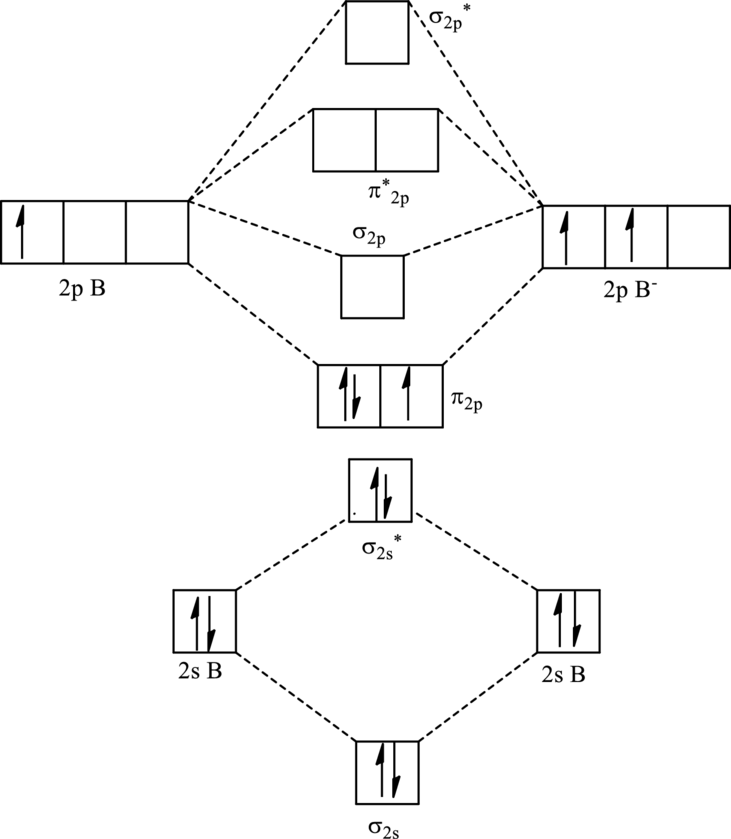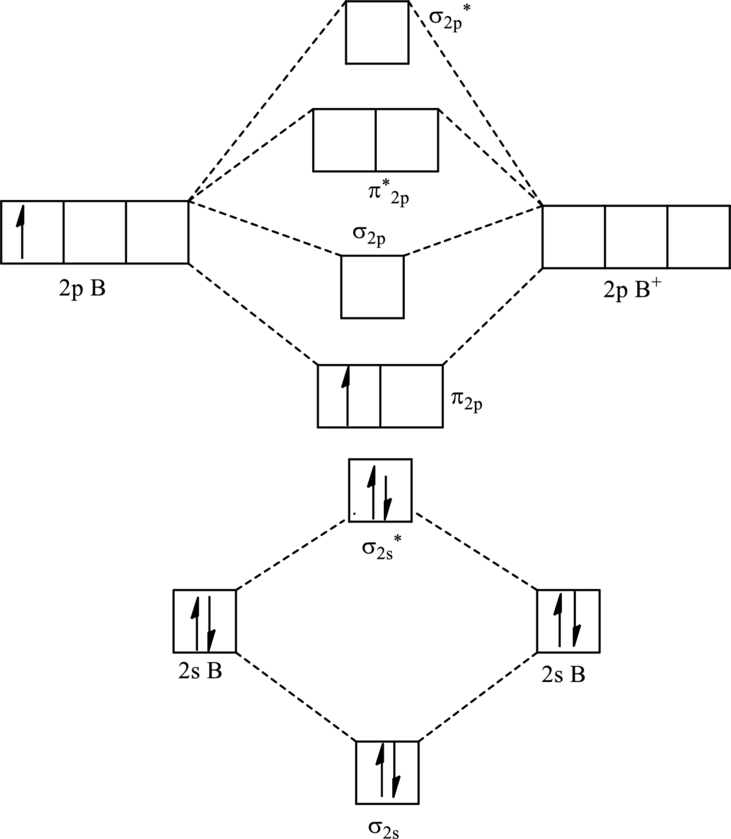
Concept explainers
(a)
Interpretation:
Bond order with molecular orbital diagram of
Concept Introduction:
Molecular orbital diagram is a linear combination of atomic orbitals of similar energy and similar symmetry. It is formed by the proper overlap of the atomic orbitals.
There are 3 types of molecular orbitals as follows:
- 1. Bonding molecular orbital: They are formed by the constructive interference of atomic orbitals and electrons in it stabilize the molecule and are of lesser in energy.
- 2. Antibonding molecular orbital: This type of orbitals increases the energy of molecule and destabilizes it and weakens the bond between the atoms.
- 3. Non-bonding molecular orbital: These types of orbitals have energy similar to atomic orbitals that is addition or removal of electron does not change the energy of molecule.
The order of energy in molecular orbital follows two rules as follows:
- 1. For
atomic number less than or equal to 14 order of energy is,
- 2. For atomic number more than 14 order of energy is,
Bond order
Species with number of unpaired electrons in its subshell is called paramagnetic species.
(a)
Answer to Problem 2G.2E
The molecule
Explanation of Solution
For
The symbol for boron is
Thus total valence electrons are sum of the valence electrons for each atom in
Hence, 6 electrons are to be arranged in each molecular orbital. Therefore, the molecular orbital diagram of

The electronic configuration of
Substitute 4 for number of electrons in bonding orbitals and 2 for number of electrons in antibonding orbitals in equation (1) to calculate bond order.
The molecular orbital diagram of
(b)
Interpretation:
Bond order with molecular orbital diagram of
Concept Introduction:
Refer to part (a).
(b)
Answer to Problem 2G.2E
The molecule
Explanation of Solution
For
The symbol for boron is
One negative charge is added up in a total valence count.
Thus total valence electrons are sum of the valence electrons for each atom in
Hence, 7 electrons are to be arranged in each molecular orbital. Therefore, the molecular orbital diagram of

The electronic configuration of
Substitute 5 for number of electrons in bonding orbitals and 2 for number of electrons in antibonding orbitals in equation (1) to calculate bond order.
The molecular orbital diagram of
(c)
Interpretation:
Bond order with molecular orbital diagram of
Concept Introduction:
Refer to part (a).
(c)
Answer to Problem 2G.2E
Explanation of Solution
For
The symbol for boron is
One positive charge on molecule is subtracted from total valence count.
Thus total valence electrons are sum of the valence electrons for each atom in
Hence, 5 electrons are to be arranged in each molecular orbital. Therefore, the molecular orbital diagram of

The electronic configuration of
Substitute 3 for number of electrons in bonding orbitals and 2 for number of electrons in antibonding orbitals in equation (1) to calculate bond order.
The molecular orbital diagram of
Want to see more full solutions like this?
Chapter 2 Solutions
CHEMICAL PRIN. (LL)+ 2 SEM SAPLING >BI<
- It is possible to write a simple Lewis structure for the SO42- ion, involving only single bonds, which follows the octet rule. However, Linus Pauling and others have suggested an alternative structure, involving double bonds, in which the sulfur atom is surrounded by six electron pairs. (a) Draw the two Lewis structures. (b) What geometries are predicted for the two structures? (c) What is the hybridization of sulfur in each case? (d) What are the formal charges of the atoms in the two structures?arrow_forwardCalcium cyanamide, CaNCN, is used both to kill weeds and as a fertilizer. Give the Lewis structure of the NCN2 ion and the bonded-atom lone-pair arrangement and hybridization of the carbon atom.arrow_forwardIn the molecular orbital mode l, compare and contrast bonds with bonds. What orbitals form the bonds and what orbitals form the bonds? Assume the z-axis is the internuclear axis.arrow_forward
- Could the anion Li2 exist? What is the ions bond order?arrow_forwardAspirin, or acetylsalicylic acid, has the formula C9H8O4 and the skeleton structure (a) Complete the Lewis structure and give the number of bonds and bonds in aspirin. (b) What is the hybridization about the CO2H carbon atom (colored blue)? (c) What is the hybridization about the carbon atom in the benzene-like ring that is bonded to an oxygen atom (colored red)? Also, what is the hybridization of the oxygen atom bonded to this carbon atom?arrow_forwardIdentify the hybrid orbitals used by antimony in SbCl5 and in SbCl6, the ion formed from the reaction of SbCl5 and Cl. Explain your choices.arrow_forward
- Compare and contrast the molecular orbital and ionic bonding descriptions of LiF.arrow_forwardDescribe the hybridization around the central atom and the bonding in SCl2 and OCS.arrow_forwardIn each of the following molecules, a central atom is surrounded by a total of three atoms or unshared electron pairs: SnCl2, BCl3, SO2. In which of these molecules would you expect the bond angle to be less than 120? Explain your reasoning.arrow_forward
 Chemistry: Principles and PracticeChemistryISBN:9780534420123Author:Daniel L. Reger, Scott R. Goode, David W. Ball, Edward MercerPublisher:Cengage Learning
Chemistry: Principles and PracticeChemistryISBN:9780534420123Author:Daniel L. Reger, Scott R. Goode, David W. Ball, Edward MercerPublisher:Cengage Learning ChemistryChemistryISBN:9781305957404Author:Steven S. Zumdahl, Susan A. Zumdahl, Donald J. DeCostePublisher:Cengage Learning
ChemistryChemistryISBN:9781305957404Author:Steven S. Zumdahl, Susan A. Zumdahl, Donald J. DeCostePublisher:Cengage Learning
 Chemistry: The Molecular ScienceChemistryISBN:9781285199047Author:John W. Moore, Conrad L. StanitskiPublisher:Cengage Learning
Chemistry: The Molecular ScienceChemistryISBN:9781285199047Author:John W. Moore, Conrad L. StanitskiPublisher:Cengage Learning Chemistry: Principles and ReactionsChemistryISBN:9781305079373Author:William L. Masterton, Cecile N. HurleyPublisher:Cengage Learning
Chemistry: Principles and ReactionsChemistryISBN:9781305079373Author:William L. Masterton, Cecile N. HurleyPublisher:Cengage Learning Chemistry: An Atoms First ApproachChemistryISBN:9781305079243Author:Steven S. Zumdahl, Susan A. ZumdahlPublisher:Cengage Learning
Chemistry: An Atoms First ApproachChemistryISBN:9781305079243Author:Steven S. Zumdahl, Susan A. ZumdahlPublisher:Cengage Learning





